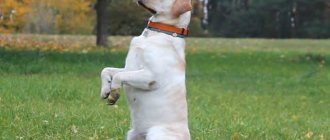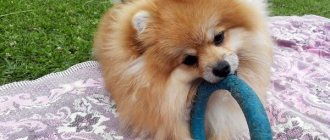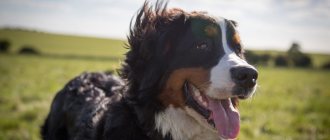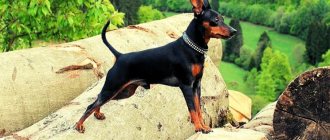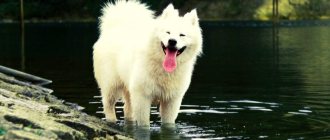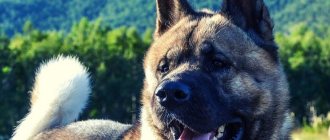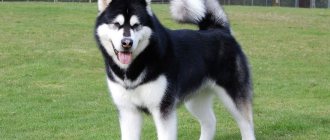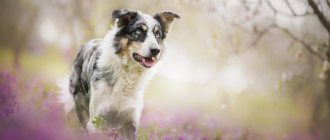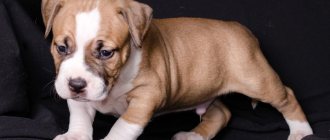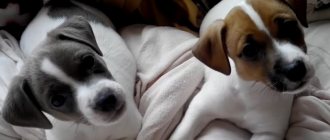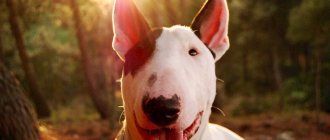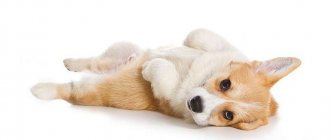Raising a dog is about developing correct behavior. This is the basis for successful training. Training is a set of activities aimed at training specific teams. It is necessary to start raising a puppy from the very first days of his appearance in the house. If you work with your pets from a very early age, then you are on the right track.
The Shiba Inu dog breed was originally bred to catch birds and small game, and was sometimes used to hunt wild boar. It is one of six native Japanese breeds: Akita (large), Kishu, Hokkaido, Kai, Shikoku (medium), and Shiba Inu (small). Shiba Inus are known for their energetic nature, small upright ears, and cat-like agility. Today they are used as a companion dog.
- Country of Origin : Japan
- Height at withers : males 40 cm, females 37 cm
- Weight : males 9-14 kg, females 8-13 kg
- Lifespan : 12-15 years
- Use : companion dog, hunting
When to start training your puppy
The baby's training begins immediately after purchase.
The common belief that they begin to train a pet at six months of age is incorrect. Rules of behavior in the house are instilled from the first day. Inexperienced owners consider this to be very stressful for the animal, but with a delicate approach it will help establish contact with the pet and begin to build trust between the owner and the puppy. Shiba Inu training begins at 2 months. At this time he is in quarantine due to vaccination and does not go for walks. They are taught to go to the toilet wearing a diaper. Training a puppy to be hygienic is a long process, and initial results do not guarantee success. Training continues according to plan so as not to repeat it. They are taught to use a leash, collar and muzzle at home. When the dog goes outside, he will experience stress from wearing accessories.
At two months of age, the puppy is given boundaries and rules. Playing is allowed with toys, not with the owner's things. Biting hands during the game is prohibited. Attempts to chew clothes, shoes, furniture, and barking without a command are suppressed.
Take the Attention Test! Find 10 differences! (click right here!)
Find the answer Are you bothered by some problem or question? Enter “Breed” or “Name of the problem” into the form, press Enter and you will find out everything about the issue that interests you.
At this stage of training, harsh punishments are avoided and praise is preferred so that the dog does not grow up embittered or intimidated. The dog is allowed to explore the world around it as long as it does not go beyond the established limits.
History of the breed
It is possible that the Shiba Inu breed is the oldest Japanese breed. The mention of it dates back to the 6th century BC.
The breeding dogs from which the modern one was bred through selection belonged to three main types:
- red shinshu-shiba;
- dark red mino-shiba;
- black and white san'in-shiba.
The resulting breed made it possible to set a standard.
Did you know? "Shiba Inu" means "small bush dog."
The Shiba Inu dog standard was approved in Japan in 1934, later revised in 1987 and 1993. During World War II, the breed was under threat, but Japanese specialists were able to restore the population. And now the breed is recognized by all world canine organizations.
Today, the Japanese Shiba Inu dog breed is distributed on all continents: Eastern and Western Europe, Asia, Australia, North and South America.
Did you know? The Shiba Inu is one of the most popular breeds in the United States.
Socialization and training
From 3 months the pet begins to get acquainted with the world outside the apartment. The walks are short at first so that the puppy does not get tired. You are allowed to go to the toilet outside, and are gradually weaned off the diaper.
A separate part of training is communication with people and dogs. The pet should not approach every animal. It is important to secure the moment. Treats are accepted only from the hands of the owner. Taking it from people or picking it up from the ground is prohibited.
The necessary commands begin to be taught at 4-5 months. First skills:
- Know the nickname.
- Calmly follow next to the owner.
- Return upon request.
- Commands “sit”, “stand”, “lie down”.
- Prohibitory signals - “fu”, “no”.
- Stop barking at the owner's request.
From six to seven months, problems with training appear due to puberty, the dog becomes disobedient, forgets commands, and does not recognize the owner as a leader. At this age, a rational decision would be to send your Shiba Inu to a training course with professional dog handlers.
Differences between a pet and an Akita Inu
In the photo, some similarities between Akita Inu and Shiba Inu dogs are striking. Yet, despite the similarities, these are completely different breeds.
The first distinguishing feature is the height of the dog: the Akita is taller and stands at about 70 cm, while the Shiba Inu is not very tall.
There are also significant differences in the character of these breeds. While the Akita is calm and distinguished by its measured behavior, its unobtrusiveness and kindness, the Shiba Inu is possessive. Shiba very often shows belligerence, which is expressed in relation to both people and things.
Akita is a guard, Shiba Inu is a hunter.
Owner experience
Do not train your baby if you are in a bad mood, dogs are excellent psychologists, and your depression can rub off on them. Both puppies and adults copy their owner in everything; a loving dog will try to be with you.
Dogs are able to find a special approach to everyone in order to satisfy their whims. There are no two identical puppies or adult pets; each has a different character and habits.
His character in the future depends on training. It depends on you whether your pet will grow up to be a cheerful and devoted friend or a nervous, unsociable creature.
Feeding
Food familiar to humans can cause allergies in a Shiba, since this breed originated on islands where fish is considered the standard diet. In this case, the easiest way would be to choose ready-made dry food, completely balanced and containing one type of protein.
If you are a person who prefers natural feeding, you should consider some features. The main product is fish: tuna or salmon. From time to time, fish can be replaced with lamb or duck.
Both fish and meat must undergo heat treatment before consumption. This will reduce the risk of an allergic reaction.
Rice porridge is good for animals. It is also recommended to add vegetables, a source of vitamins and fiber, and fermented milk products to the menu.
Fermented milk products must be low-fat. They should be given to a pet only if they do not harm the animal’s digestion.
If there is a need to switch your pet to another food, it should be taken into account that this must be done gradually.
If a food allergy or intolerance occurs, you should completely switch to special veterinary food.
It should be noted that dogs are strictly prohibited from giving foods such as smoked meats, baked goods, sweets and chocolate.
Why train
Training a dog at home has 3 goals:
- The pet must recognize the owner as a leader.
- The person will know well how to behave with the pet.
- A trained dog is a socially adapted pet.
The owner must choose whether to use deterrents or rewards for a motivational item.
The greatest impact is achieved when the dog receives praise right away.
Containment methods:
- Using objects that can attract the dog's attention. Things that make sharp sounds - whistles, a bunch of keys, a rattle from a tin can with pebbles, etc.
- If the actions are not followed, the dog loses the owner's attention. She is sent to her place without the usual stroking and praise, in a stern voice.
Pet restraint methods can be used on older puppies older than 4 months. If the dog is unbalanced, then this method should not be used.
Ignoring a pet is a more effective technique than physical influence.
Training is quite a labor-intensive task, but teaching a dog to behave correctly is easier than correcting inappropriate behavior.
What to feed?
The basics of feeding dogs are relatively simple. To determine the serving size, consider your pet's body weight . Then make adjustments based on your activity level.
The food can be natural and dry:
- In a natural diet, the main ingredients should be meat and fish. Porridge occupies the second most important place in the Shiba Inu diet, because it is not only a source of protein, but also carbohydrates. Vegetables and fruits are also needed, but in small quantities.
- Industrial food contains everything necessary for the healthy development of your pet.
There are concentrates that are given dry or after soaking in broth or water. The dog gets used to the food, so do not change it too often. This may lead to indigestion.
Adult dog
Like all living things (including you!), dogs require a balance of certain nutrients in their diet to maintain health and longevity. Food quality matters! The most important elements for dogs are proteins and fats:
- Protein is made up of amino acids, which provide the building blocks for healthy cells, tissues and muscles. Helps maintain muscle mass.
- Fat plays a role in the absorption of nutrients and the production of hormones. It is also a highly concentrated source of energy for your dog.
Carbohydrates should be included in the diet of an adult dog, but in limited quantities. Consumption helps improve the functioning of the body, prevents diabetes and obesity.
Important! Eating grains (millet, barley and others) by your dog can be dangerous! The high glycemic index of these foods leads to a sharp spike in blood sugar.
Feed twice a day.
Puppy
Protein and fat are also important elements in a puppy's diet. The nutrition of a growing body should be no less varied than that of an adult. Inexperienced owners often wonder what volume of portions should be given.
Overfeeding and underfeeding are equally harmful for fragile puppies. Carefully watch how the babies eat - this will make it easier for you to understand whether there is enough food or too much. Puppies up to ten months are fed no more than six times a day, increasing the portion size over time. Upon reaching ten months of age, they are fed twice a day, like an adult dog.
Important! Add special additives to your puppy's food. For example, calcium or fatty acids will help form strong bone tissue and ensure healthy growth.
Natural food
Foods rich in proteins and fats:
- boiled and raw meat scalded with boiling water (beef, rabbit, poultry);
- sea fish (salmon, tuna, etc. - always heat-treated);
- dairy: cottage cheese, kefir, low-fat sour cream;
- boiled chicken egg;
- soup sets (heart, kidneys, liver, bird giblets, etc.);
Carbohydrates:
- vegetables and fruits in small quantities (boiled potatoes, cauliflower, carrots, zucchini, pumpkin, etc.);
- porridge (buckwheat, rice, semolina).
Important! You can’t give sweets and smoked foods! They harm digestion!
For a novice trainer
To prevent training from turning into torture:
- Take your pet for a walk beforehand. A tired, running dog is less distracted. The effect will be greater. Active walking makes working with the animal easier.
- The command is spoken once.
- Take pauses. When practicing, for example, “near”, “lie down”, “fetch”, you need to give the dog time to take a breath. 5-10 seconds will be enough.
- Change the sequence. If the dog gets used to doing everything in order. That, for example, after “to me” you need to “sit.”
- You can't overload it. Too intense training can harm the animal.
An already trained dog follows commands under any conditions. But your pet may get tired.
- Sometimes students, like ordinary schoolchildren, “run away from class.” They may be distracted by a nearby cat or other animal. Be more careful with your exposure. Train her on a long leash. This will allow you to catch up with the “mischievous person”, even if he runs fast. A leash with a carabiner for 3-5 meters is suitable. Often such a leash is just needed for endurance and training to pick up “goodies” from the floor.
- “Mass” training is not allowed. Only the owner should act as a trainer. Otherwise the dog will be distracted.
- It's worth pausing. If the animal doubts the correctness of the actions, the reason is the load. Give your dog a simple command and then praise generously. When she sees that the owner approves of him, she will begin to perform the exercises better. Play or take a walk with her.
- Commands are studied systematically and gradually. You need to train your pet to obey in any conditions. Start in a quiet place, gradually adding more “stimulants.” Create them. For example, scatter treats, call a friend to pass by the training place.
To train an animal, you need to be patient and perform the exercises systematically.
Basic rules of care
How to care for Shiba Inu puppies:
- The dog's place should be protected from cold and drafts.
- For the first few weeks, the pet should be in a calm environment and have contact only with family members.
- At the initial stage, the dog is fed the same products as the breeder, and only after 3 months of age can the diet be changed.
- You need to walk your young pet 3 times a day. In the morning - approximately at 6-76 o'clock, at lunch - at 13-14 o'clock and in the evening - at 19-20 o'clock. The duration of each walk is 30-40 minutes.
- Brush your dog daily, this will keep its coat smooth and silky and its skin healthy.
- After 6 months of age, the dog can be bathed no more than once every 2-3 months.
- The puppy's eyes and ears should be examined daily for discharge and dirt.
- About once a week, the pet’s ears are cleaned with a cotton swab or disk, and a special lotion is also used.
- If the dog's eyes are clean, then they do not need treatment.
- The pet's diet must be selected in such a way as to provide it with the required amount of nutrients.
- It is highly advisable to brush your dog’s teeth once a week and regularly examine them for the appearance of tartar. If it appears, you should contact your canine dentist.
- Once every 3 months, the dog must be given anthelmintic drugs.
- As early as possible (at about 2-3 months), you need to accustom your dog to trimming its nails.
- Be sure to take your dog to the veterinarian every six months.
General training course
The general training course is based on systematic training. The skills developed during the general course form the basis for the formation of conditioned reflexes in the animal.
https://dog-care.ru/dressirovka/obuchenie/kak-dressirovat-siba-inu.html
The first skill is to teach the puppy to go to the toilet only outside. During the learning process, it is necessary to practice instructions with gestures and voice.
General skills and abilities include:
- Response to nickname;
- Habit of a collar, leash, harness;
- Approach to the trainer;
- Walking nearby;
- Habit of lying, sitting, standing, crawling positions;
- Ability to follow voice commands, stop certain actions, overcome obstacles;
- Refusal of other people's food;
- Tolerance to noise stimuli.
General principles of animal training
To successfully train a pet, systematic training is necessary. The duration of the lesson should not exceed 2 hours. Commands for dogs: the list of techniques practiced in the lesson depends on the level of training of the animal; for example, a Labrador puppy begins to be trained from the first months. Gradually the number of teams should be increased.
New techniques are practiced in the first part of the lesson. After each command, a three-minute break is required for the pet.
Rules for successfully training a puppy:
- Techniques performed correctly should be reinforced with praise and encouragement.
- It is better to voice the instruction once, accompanied by a gesture.
- Maintaining consistency in orders and gestures.
- The first classes are conducted in a familiar environment, then change the environment.
- The trainer and the dog are in a good mood.
- It is better to end the lesson with an instruction that the puppy does better than others.
How to choose?
Advice from experienced dog breeders:
- Never buy a puppy at a poultry market; find a specialist who breeds dogs of this particular breed.
- You should not buy the first puppy you come across; examine several individuals before making a decision.
- Never agree to meet with a breeder on neutral territory; examine the babies directly at the kennel, so you can see the conditions in which the dogs are kept.
- Ask the seller to show the baby's mother and father. If the father is absent, a professional breeder always has his photo.
- When examining parents, you should pay attention to their breed characteristics.
- Be sure to ask the breeder to show the parents' documents, as well as the veterinary passport and puppy card of the chosen pet.
- Clean, well-groomed and well-fed dogs in the kennel are a good sign.
- Examine the puppy itself. A healthy pet has smooth shiny fur, clear gases (no discharge), clean skin and mucous membranes. A healthy puppy is inquisitive and active without being nervous.
Release command
The instruction “Walk” (“Walk” or “Fri”) is a release for dogs that serve in the search and protective guard service.
A professionally working dog, when he is outside the apartment or outside the enclosure, is in a state of “at work”. He rests according to the instructions “Lie down” or “Place”.
If you release your pet with the word “Go for a walk,” then no training is required, the dog will remember it at the same time.
Command your pet to “Sit”, and then release it, joyfully saying “Walk!” If he doesn’t move, then you can, repeating “Walk, walk,” pat her a little, clap your hands, or run forward.
Take breaks every 15-20 minutes.
Dry or natural food, which is better?
Both ways of eating have their pros and cons.
Dry food already contains all the necessary substances . In addition, it is much cheaper and easier to feed your dog with it. The owner does not need to select food and cook every day. The main disadvantage of dry food is preservatives and other harmful additives.
Natural nutrition is more natural. Meat, fish, and vegetables give the dog everything he needs for a healthy life and does not contain harmful components .
"Place" indication
Command “Place” and entice him with a treat. On the lounger, praise and give a piece.
Gradually increase the time between arrival and reward, and then give treats occasionally. In everyday life, the “Place” command is used when a pet behaves badly (for example, begging from the table or jumping on guests).
By giving the "Place" command, you tell the dog exactly where he needs to go. They quickly grasp the meaning of this command and leave offended.
If he pesters you, then you need to command “Place” again in a more menacing tone.
Before teaching the “Place” command, make sure that the dog knows the “Lie” and “Come” commands.
Step 1: Place him on a long leash and make him lie down.
Step 2. Place a large item, such as a backpack, next to it. Do not use someone else's things or his things (muzzle, toy or bowl).
Step 3. Repeat the “Down” command to him and move away 5 steps.
Step 4: Wait 3 seconds and then command “Come.” When he approaches you, praise him.
Step 5. Give the “Place” command by pointing your hand at the backpack. Move towards the thing, but don't pull on the leash. As you walk, joyfully repeat: “Place. Place".
Step 6. Once in place, command “Down” and give a treat.
Repeat the exercise. Get him to go to the place without your help. Gradually increase the distance and stop using the leash.
The pet must approach the thing lying 15 meters away, lie down and wait (30 seconds) for you to allow it to leave the position. Teach him to stay still when people or animals walk nearby.
If the dog breaks away without a command, bring it back, repeating: “Place.” If the dog refuses to return to its place without you: call the dog left near the thing, sit it next to you and command “Wait.” Then show the dog the treat and go to the “spot” alone. Place it on your backpack and return to the dog. Command “Place”, and if the dog runs up to the thing and lies down, praise it and let it eat a piece.
Dog appearance (standards)
Dimensions
Males of this breed are 40 cm tall, and females are 37 cm tall. Females weigh from 7 to 9 kg, males weigh a little more: from 10 to 13 kg. Small deviations in one direction or another are allowed.
A larger female dog should still have a feminine appearance, and an inconspicuous small dog should have well-developed muscles.
Wool
A representative of the breed has a coat consisting of two layers. The top layer is distinguished by long and coarse hair, while the bottom layer consists of soft and short undercoat. There is short hair on the animal's face. The dog's fur fits tightly to the body, with the only exception being the fluffy tail.
Colors
The most popular color of a dog of this breed is bright red. It is he who is given the greatest preference. In addition to this color, there are several others recognized as a standard. This is a black color with tan, as well as a zonal color, in which the color spots are unevenly distributed.
Zonar colors come in sesame, red sesame and black sesame. Just sesame is when black and white hairs are placed in relatively equal proportions on the animal’s body. With red sesame, red hairs predominate in color; with black sesame, black hairs predominate.
Animals with a completely white color look very chic. But such Shiba Inus will not be able to qualify for participation in exhibitions, since their color is not recognized as a standard.
Teeth and jaws
The dog's teeth are white and strong, its jaws are quite powerful.
Eyes
The Shiba Inu has brown, deep-set eyes that are shaped like a triangle.
Body and limbs
The animal is built very proportionally, its body is muscular and strong. The paws are quite strong, with the hind legs being more powerful than the front ones.
Tail
The Shiba Inu dog has a high-set tail. It seems to be wrapped in a ring, wide at the base. In general, the tail is thick and strong, covered with hair that does not fit tightly, rather sticks out.
Rock defects
Disqualifying defects for the Shiba Inu breed are as follows: inappropriate coloring, sagging ears, thin short tail or tail not wrapped in a ring, missing teeth, malocclusion; the dog's aggressiveness or cowardice.
Common mistakes when training
- The dog is unconscious of its actions and does not understand human speech. When giving a command, you cannot talk; conditioned reflexes are inhibited. All commands are pronounced without further ado.
- Violations of the order of skill development. From simple to complex. Until the dog has mastered a certain command well, you cannot proceed to the next one.
- The dog handler does not take into account the characteristics of the animal, which reduces the effectiveness of training.
- Retraining. Frequently practicing the same skills helps to fatigue, reduce performance and overload the nervous system. Once the technique is learned, it is no longer performed that day. If she refuses to perform a skill as a result of overtraining, then she is given a rest for 2-3 weeks. Dog handlers monitor the condition of the dog during training.
- Incorrect voice intonation changes the sound of the command. You cannot pronounce everything in one intonation, otherwise it loses its significance as an irritant. The dog will stop responding to her.
- Incorrect use of directions. You can’t repeat it often, otherwise you’ll develop the skill of doing it when you repeat it.
How to bathe? Cleaning teeth, ears, trimming nails, grooming
Basic rules for swimming:
- It is not advisable to bathe your Shiba Inu baby before the age of 6 months.
- Starting from six months, this should be done once every 2-3 months using special shampoos and conditioners.
- The temperature for swimming should be 38-40 degrees.
- A diaper or a special mat is placed at the bottom of the bath to prevent the dog's paws from slipping.
- When bathing for the first time, there should not be a lot of water in the bath so that the dog does not get scared.
- After the procedure, the pet is wrapped in a soft towel and gently blotted, and then dried with a hairdryer.
The puppy's ears should be cleaned once a week, using a cotton pad or swab dipped in a special lotion . The auricle is wiped both from the outside and from the inside, treating the surface first with a damp and then a dry swab.
Teeth brushing is carried out once a week using a special paste and brush for dogs.
The pet's nails are trimmed as they grow . For the procedure, a special bone cutter is used, which allows the procedure to be carried out painlessly and without injuring the pet. After which the claws are treated with a nail file to prevent cracking.
You need to brush your Shiba Inu puppy daily using a special massage brush . The procedure stimulates blood circulation and promotes healthy skin and coat.
